If you are a novice guitarist or a frustrated beginner, then you are probably still experiencing some sort of unpleasant noise or lack of clarity when playing your basic guitar chords.
In this post, I’ll share with you five basic tips I give out to students on a daily basis to help them overcome this frustrating part of guitar playing.
Firstly, these tips are for those playing the basic guitar chords such as G, C, D, Am, Em as well as the other ones mentioned in my popular free mini chord eBook.
If you can play those chords 100% cleanly and clear 100% of the time you are probably past this stage but the truth is many guitarists who want to play but give up the guitar do so due to two hugely frustrating reasons…
- Messy sounding chords
- Slow chord changes
This particular post is all about cleaning up the chords but if you want help with chord changes, check out these tips on improving them.
Whenever I get a new student walk through the door they usually fall into one of two categories – absolute beginner who has never played before or a frustrated novice who struggles to get their chords sounding clear.
5 simple tips on how to make your basic guitar chords sound clearer
One of the first things I do with these struggling students is to get them playing their basic chords with perfection, confidence and complete clarity while ensuring less strain and stress is being used – this is how we do it.
1) Cut the fretting hand nails short
This is an absolute must but you would be surprised at how many students don’t follow it!
These days I ensure all students make cutting their nails a habit and I check the nails of students very often.
If your fretting hand nails are long then the rest of the tips in this post won’t really matter all that much – it is that crucial.
I taught a young fella in a school once whose nails were so long he reminded me of Wolverine! It was his first lesson and he didn’t know better but I’ve also taught much more experienced players who would often forget this.
Don’t be one of those people. Make it a conscious effort to keep your fretting hand nails short.
You need to cut them short to the point that you can’t see the white part of the nail right on the tip.
According to the American Academy of Dermatology, your fingernails will grow at a rate of 3.5mm each month and your toenails grow at 1mm each month.
So if you play the guitar with your feet you will be okay.
In all seriousness though, this shows that if you cut your fingernails and toenails with the same regularity then that is not going to be enough.
One thing to note if you are a fingerpicker, your picking hand nails need to be groomed differently than the fretting hand nails, and you can find out more about that in my Fingerpicking Essentials course.
2) Use a capo to incrementally help with any stretches
This is such a simple little trick that no one really seems to teach as far as I know but makes a massive different to beginners.
If you were to place a capo on the 5th fret of your guitar and play a tricky stretch chord such as a C Major you will notice the stretch from the index to the ring finger is far less than if you were to try the same chord without the capo.
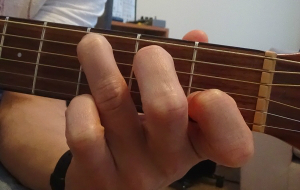
No capo – big stretch!
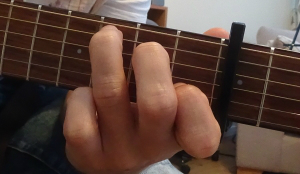
5th fret capo – easier stretch!
In fact, the difference on my Cort acoustic is as follows:
- No Capo 71mm
- 5th fret Capo 58mm
In other words, where you would play a C Major with no capo the distance is 71mm and where you would play a C Major with a capo on fret 5, the distance is 58mm.
That 13mm is huge when we are talking about guitar playing. Therefore if you struggle to stretch to play a chord put a capo on and play it higher up.
Fret 5 is a good place to start but go higher if you need to.
Before anyone argues that using a capo is taking the easy way, it is not – it is simply making the guitar more playable and helping you stretch your fingers out at a point on the fretboard that is going to push you but not push you so hard you strain your fingers or throw the guitar in the nearest river out of frustration.
Once you can play the tricky chord with the capo on the 5th fret, make it sound great and so your fingers aren’t splitting at the seams trying to hold the position, play the exact same chord but move it down a fret (along with the capo of course) to the 4th fret.
Once this is achieved, master the chord at fret 3, then fret 2 and so on until you no longer need the capo to help you play the chord.
Capos are wonderful tools for any guitarists for a variety of reasons and this is one of the most powerful.
The great thing is there are loads of songs you can play using a wide variety of chords with the capo in many places.
3) Keep your thumb low on the neck
One of the main reasons a student struggles to get a clear sounding chord is because their fingers aren’t at the correct angle and the backs of certain fingers are killing the string below it.
This is super common on the chords of D Major and C Major but happens frequently on other chords too.
What you need to do is get the last digit of each finger at least 90 degrees to the fretboard (but ideally more).
The problem is that the thumb position often makes this impossible.
If your thumb is poking out over the top of the fretboard like in the photo below then there is no real way you will get this minimum 90-degree angle unless you have the flexibility of an Olympic gymnast.
Keep an eye on your thumb, keep it fairly low on the fretboard and this will allow your hand to be in a lower position in relation to the fretboard and then your fingers can be placed on the fretboard at a better angle – just like below…
The difference having a low thumb as opposed to a high thumb will probably only make a small difference in terms of the angle of your fingers – but this difference can and is often huge in terms of whether or not the chord sounds clear or frustratingly muted.
4) Dig your nails into the fretboard to improve your finger angle
Another powerful tip to help get your fingers at the correct angle, (once you have ensured your nails are short and your thumb is low), is to aim to dig the tip of your nails into the fretboard when playing a chord shape.
This is because you must get your fingers to at least a 90-degree angle to the fretboard as pointed out earlier. Most guitarists don’t get anywhere close to 90-degrees.
They go to a point that looks okay. It appears to be okay and looks like it should work but the problem is that the back of a finger is very likely to be touching a string below it and therefore muting it, making the chord sound bad.
Instead, it is best to go too far past the 90-degree angle than not far enough.
- Aim to get the fingers past 90 degrees as this will ensure the backs of the fingers are less likely to be touching the string below it.
- The cue I give to students to help them achieve this angle is to ‘dig the nail into the fretboard’.
- You want to actually feel like the tips of your nails on the fretting hand are touching and digging into the wood of the fretboard (don’t worry you won’t do any damage to it).
Over time, you will learn to adjust your fingers so they aren’t at such an angle and you will start to know exactly what angle works for you in terms of clearing the strings.
For now though, get your confidence and clarity with the chords by tilting those fingers so the nail is digging into the fretboard.
5) Use a pick and pluck each string individually
This is such a simple tip and one you might not think will make a difference but boy, does it.
Whenever a beginner walks in and plays a chord and it sounds messy part of the issue is their picking hand is often doing this wishy-washy strum with their thumb that is so quiet and weak.
This is definitely one of my pet hates as a teacher and one I get the student to erase quickly.
Trying to play a chord by giving it a soft strum with the thumb actually makes it hard for the student to hear what is actually happening.
What’s worse is that they strum all the strings at once so there is no real way they can hear which strings sound good and which strings sound bad in the chord.
I think this is part of a confidence thing – the student knows the chord is likely to sound bad so they play it quieter, but because they play it quieter they can’t hear what is wrong with the chord and therefore they don’t know what to fix – and the dreaded cycle continues.
What you need to do is this:
- Grab a pick, ideally a nice medium gauge one such as a 0.68 (or one recommended in my post on picks)
- Slowly and individually arpeggiate each string (in other words pluck each string in the chord in order from the root note)
Doing this will help you hear exactly what is right and what is wrong with the chord and then you can quickly fix it.
Let’s face it – if you can’t hear what’s wrong with the chord, how can you fix it?
I recommend using a pick as for most beginners this will give you a louder and brighter tone than the thumb and allow you to hear right away with clarity what needs fixing.
If you prefer to play fingerstyle that is fine but for improving your chords, use a pick – it will serve you well even if you buy a few picks just for this exercise alone.
I often get emails from beginners throughout the world telling me about their frustrations, and along with slow chord changes and frustration at a lack of strumming skills, poor sounding chords is probably the most common email I get.
In fact, I categorise these frustrations into levels.
- Stage 1 – Messy sounding chords
- Stage 2 – Slow chord changes
- Stage 3 – Lack of strumming skills
The good news for most guitar students is that they eventually get past this stage 1, but usually, most guitarists do it the hard way by trial and error.
Even then they get stuck at the next stages of slow chord changes and poor strumming skills, sometimes at similar times but usually in the above order.
Instead of struggling and guessing, apply the 5 steps I have outlined above exactly and if you are a frustrated beginner or complete novice then you will possibly shave months off the learning curve and be able to start having more fun sooner rather than later on the guitar.
Let’s have a quick recap of those 5 steps for clearer sounding guitar chords….
- Cut the fretting hand nails short
- Use a capo to incrementally help with any stretches
- Keep your thumb low on the neck
- Dig your nails into the fretboard to improve your finger angle
- Use a pick and pluck each string individually
Learning the guitar doesn’t have to be a hard slog. My bundle of eBooks is full of advice such as the above on a variety of topics including the aforementioned stage 2 and 3 frustrations of chord changes and strumming, so check that out if you are stuck there.
Also, let me know in the comments below what the most frustrating chords are for you. What other tips and tricks have you used to improve the sound of your chords?

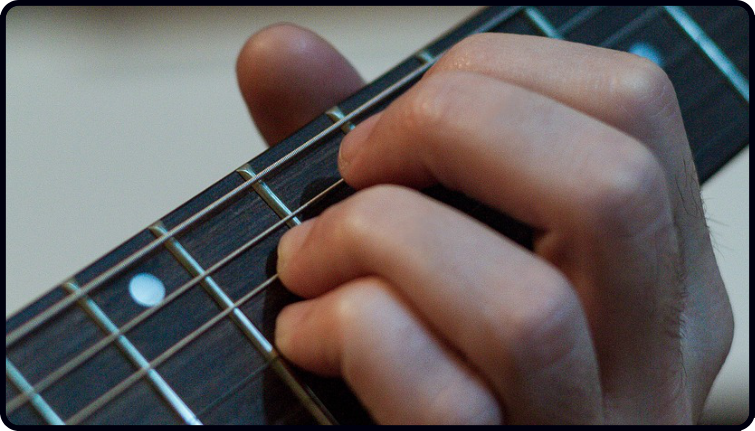
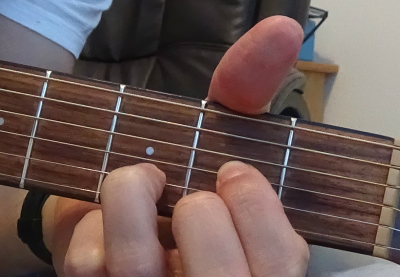
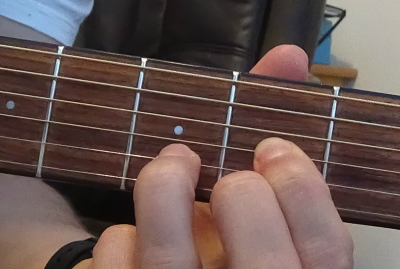
Awesome tips, I’ll use these. I normally get them to try and leave a gap at the bottom so the palm of their hand doesn’t touch the bottom of the guitar. Also obvious ones like putting their fingers near the frets.
Hey Danny, glad you found them useful. Yeah, keeping the fretting hand away from the neck and playing closer to the frets are both good tips for general playing and will often help chords sound better too. Cheers for the comment. 🙂
Great tips and very concise and well-written article. Thanks!
Thanks, Sam. Glad you enjoyed. Hope your playing is going great!
I’m a bit confused here Dan. In your post about avoiding sore and painful fingertips you talk about not pressing too hard on the strings and yet here you advocate digging your nails into the fretboard. Surely if your nails are shorter than your finger tips then you must have to press pretty hard on the strings to dig your nails in?
Hi Steve, it`s a good question. I`m happy to clarify. Yes, you should never press harder than you need to. The idea behind `digging your nails in` is not to press them hard but to get the fingers at the correct angle to ensure the chord sounds clear.
Many beginners don`t have their fingers at a 90 degree angle – this causes the backs of the fingers to touch the strings below them, which of course mutes them.
If you get the angle of your fingers sharp enough so that you can feel the nails digging in lightly on the fretboard you are in business, the fingers will be at the correct angle and the chord will sound clearer.
Your article has a really good information and awesome tips. Please keep up the good work. Your information helps me a lot to increase my guitar skills. Photos are well arranged.
Thank You….
Thanks, glad you enjoyed it, Yash. All the best. 🙂
Thanks for these tips. I am 72 and started playing the guitar!
Tomorrow I will buy a capo ( and a strap).
I find the F cord ” impossible to play”??
It`s my pleasure, Gideon. Great to hear it! As for the F chord, check out this post for some help. Good luck! Dan
Hello. I am learning to play guitar for about 7 months now. Am really practicing very hard but my chords are just not sounding right. Afraid I am getting a bit demotivated and frustrated.. I am reading all over in google.. about lots of practice will eventually get you there ….my question is how much of practice do you need. I am basically stuck to my guitar for hours, I just want to cross this line of the chord sound..not sure if I am doing something wrong. Some tips or am I asking for to much to be accomplished in 7 months…
Hi, it is not about the amount of time you are pracitsing but the quality of practice you are doing. It sounds like the amount of time is good but you need to make it a habit to get your chords sounding clear every time.
Try this, pick 5 chords, I usually recommend the common open chords of C Am G Em D. Put a capo on where comfortable and play each chord 5 times ensuring they sound 100% clear. Take your fingers off and return them each time. If one note buzzes, start again from 0.
The aim is to play each chord 5 times in a row perfectly without error. This will help you build up the habit of getting your chords perfect every time. Also, remember 7 months is not a massive amount of time. Do the above every day and in a month your chords will definitely sound better. This is what I get all my students to do.
I hope that helps and stick with it!
Using capo is a great idea, I used to play with it when I was still learning the guitar and its help a lot, doing finger exercises is advisable also, its good start with it before playing the guitar.
[…] to this but then get frustrated when some days things which should be simple, such as getting clear chords, are easy and other days there is the sound of the oh-so-annoying `muted […]
[…] The G to C change in Mother is one that happens in a lot of songs and is one of the toughest changes in the book. As a side note, a lot of beginners struggle just to play the C chord cleanly so you should use a capo to practise with at first as explained in this post on getting clear chords. […]
Great tips. I’ve been playing for a while now, on and off, and find myself having to relearn the muscle memory and nuance that accompanies guitar playing. Through focused practicing, I find myself playing 1 single song over and over again, and eventually it starts clicking together. Though I will say I do get irritated with how prone I am at usually making at least 1-2 mistakes during the song as I find my mind begins to always wander somehow. Definitely one of the biggest hurdles I need to overcome when it comes to playing guitar.
Do you find yourself still making mistakes from time to time when you play, and if so, how often do they occur? Thank you for the awesome post and all the great information you have provided us.